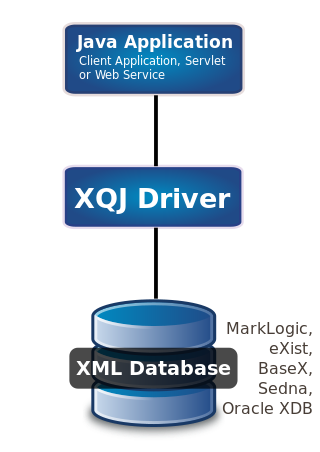Berkeley DB (BDB) is an embedded database software library for key/value data, historically significant in open-source software. Berkeley DB is written in C with API bindings for many other programming languages. BDB stores arbitrary key/data pairs as byte arrays and supports multiple data items for a single key. Berkeley DB is not a relational database, although it has database features including database transactions, multiversion concurrency control and write-ahead logging. BDB runs on a wide variety of operating systems, including most Unix-like and Windows systems, and real-time operating systems.

Extensible Markup Language (XML) is a markup language and file format for storing, transmitting, and reconstructing arbitrary data. It defines a set of rules for encoding documents in a format that is both human-readable and machine-readable. The World Wide Web Consortium's XML 1.0 Specification of 1998 and several other related specifications—all of them free open standards—define XML.
In computing, the term Extensible Stylesheet Language (XSL) is used to refer to a family of languages used to transform and render XML documents.
XSLT is a language originally designed for transforming XML documents into other XML documents, or other formats such as HTML for web pages, plain text or XSL Formatting Objects, which may subsequently be converted to other formats, such as PDF, PostScript and PNG. Support for JSON and plain-text transformation was added in later updates to the XSLT 1.0 specification.
Java XML is a mark up language for marking up the structure of a text document. The Java programming language XML APIs developed by Sun Microsystems consist of the following separate computer-programming APIs:
Saxon is an XSLT and XQuery processor created by Michael Kay and now developed and maintained by his company, Saxonica. There are open-source and also closed-source commercial versions. Versions exist for Java, JavaScript and .NET.
XPath 2.0 is a version of the XPath language defined by the World Wide Web Consortium, W3C. It became a recommendation on 23 January 2007. As a W3C Recommendation it was superseded by XPath 3.0 on 10 April 2014.
eXist-db is an open source software project for NoSQL databases built on XML technology. It is classified as both a NoSQL document-oriented database system and a native XML database. Unlike most relational database management systems (RDBMS) and NoSQL databases, eXist-db provides XQuery and XSLT as its query and application programming languages.
An XML database is a data persistence software system that allows data to be specified, and sometimes stored, in XML format. This data can be queried, transformed, exported and returned to a calling system. XML databases are a flavor of document-oriented databases which are in turn a category of NoSQL database.
An RDF query language is a computer language, specifically a query language for databases, able to retrieve and manipulate data stored in Resource Description Framework (RDF) format.
XQuery Update Facility is an extension to the XML Query language, XQuery. It provides expressions that can be used to make changes to instances of the XQuery 1.0 and XPath 2.0 Data Model.
XPath is an expression language designed to support the query or transformation of XML documents. It was defined by the World Wide Web Consortium (W3C) in 1999, and can be used to compute values from the content of an XML document. Support for XPath exists in applications that support XML, such as web browsers, and many programming languages.
In software development XRX is a web application architecture based on XForms, REST and XQuery. XRX applications store data on both the web client and on the web server in XML format and do not require a translation between data formats. XRX is considered a simple and elegant application architecture due to the minimal number of translations needed to transport data between client and server systems. The XRX architecture is also tightly coupled to W3C standards to ensure XRX applications will be robust in the future. Because XRX applications leverage modern declarative languages on the client and functional languages on the server they are designed to empower non-developers who are not familiar with traditional imperative languages such as JavaScript, Java or .Net.
XQuery is a query and functional programming language that queries and transforms collections of structured and unstructured data, usually in the form of XML, text and with vendor-specific extensions for other data formats. The language is developed by the XML Query working group of the W3C. The work is closely coordinated with the development of XSLT by the XSL Working Group; the two groups share responsibility for XPath, which is a subset of XQuery.
Sedna is an open-source database management system that provides native storage for XML data. The distinctive design decisions employed in Sedna are (i) schema-based clustering storage strategy for XML data and (ii) memory management based on layered address space.
Virtual Token Descriptor for eXtensible Markup Language (VTD-XML) refers to a collection of cross-platform XML processing technologies centered on a non-extractive XML, "document-centric" parsing technique called Virtual Token Descriptor (VTD). Depending on the perspective, VTD-XML can be viewed as one of the following:

XQuery API for Java (XQJ) refers to the common Java API for the W3C XQuery 1.0 specification.

An XML transformation language is a programming language designed specifically to transform an input XML document into an output document which satisfies some specific goal.
Zorba is an open source query processor written in C++, implementing
Qizx is a proprietary XML database that provides native storage for XML data.




